Under-Eye Hollows
Under-eye hollows develop in the area between the lower eyelid and upper cheek. These hollows can make the eyes appear sunken and cast shadows underneath, giving the appearance of a tired and older look. A common cause of under-eye hollows is volume loss, which naturally happens as collagen and elastin levels decrease with age. For many people, these hollows can hurt self-esteem and confidence. Fortunately, non-invasive dermal fillers can help reduce under-eye hollows and refresh that area. Expert injector Dr. Michele Green in New York City has over 25 years of experience using dermal fillers to treat and diminish the appearance of hollowing under the eyes.
Dermal fillers are injectables that restore volume to specific areas. Tear trough fillers are hyaluronic acid-based fillers used to treat the delicate under-eye area and add volume to the tear trough, a crease under the eyes that can appear sunken or hollow. The most common fillers for this area are hyaluronic acid options like Juvederm, Restylane, or Belotero. After injection, these fillers instantly restore volume and smooth out under-eye hollows. Under-eye fillers are ideal for patients who want to refresh their eyes without the downtime or risks associated with plastic surgery. To ensure safety, effectiveness, and the best cosmetic results, dermal fillers should always be administered by an experienced medical professional, like board-certified dermatologist Dr. Michele Green in NYC.
Dr. Michele Green is a highly respected, board-certified dermatologist with over 25 years of experience treating discerning patients worldwide for various skin concerns, including under-eye hollows, sun damage, fine lines, wrinkles, and hyperpigmentation. She is consistently recognized as a top NYC dermatologist by Castle Connolly, Super Doctors, New York Magazine, and The New York Times due to her expertise and dedication to her patients. Dr. Green takes a holistic approach to cosmetic dermatology and follows a ‘less is more’ philosophy to achieve natural-looking, beautiful results. When you visit Dr. Green, she will evaluate your under-eye hollows and select the appropriate tear trough filler to help you achieve a rejuvenated, youthful appearance.
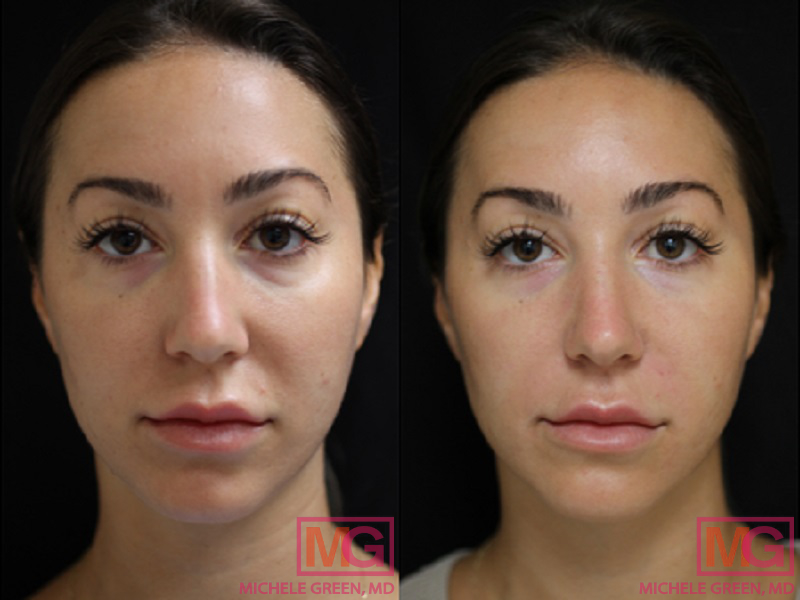
What are under-eye hollows?
Under-eye hollows, also known as sunken eyes or tear trough hollows, are noticeable indentations around the eye area between the lower eyelid and the upper cheek. These hollows often appear as dark circles under the eyes due to shadowing on the skin, which can make someone look older and more tired than they actually are. Although many factors can contribute to under-eye hollows, including genetics and lifestyle, the most common cause is the natural aging process. As we age, our bodies produce less collagen and elastin, two proteins that give the skin structure, elasticity, and firmness. When these proteins decrease, volume loss occurs, leading to hollowing under the eyes. While the appearance of sunken eyes, hollows, and dark circles can be upsetting, patients can use dermal fillers to improve the under-eye area for a natural, youthful look. These fillers restore lost volume, reduce shadowing, and smooth the skin with minimal downtime. When you meet with Dr. Green at her private NYC dermatology practice, she will evaluate your under-eye hollows and aesthetic goals to develop a personalized treatment plan to help you look and feel your best again.
What causes sunken eyes and under-eye hollows?
Common causes of sunken eyes and under-eye hollows include:
- Natural aging — As we age, our body’s production of collagen and elastin decreases, resulting in volume loss, skin laxity, and thinning of the skin under the eyes.
- Genetics — Some people are genetically predisposed to losing volume under the eyes.
- Sun exposure — Excessive sun exposure around the eyes can lead to photoaging, which causes premature signs of aging, like volume loss under the eyes.
- Rapid weight loss — Diets or medications that cause rapid weight loss can lead to facial hollowing, including under the eyes.
- Dehydration — Poor hydration can reduce water content in tissues, leading to less plumping and volume.
- Not getting enough sleep — Fatigue and exhaustion can lead to dehydration and thinning of the skin under the eyes.
- Smoking — Smoking tobacco can cause breakdown of collagen and elastin fibers, leading to premature aging and volume loss.
What medical condition causes sunken eyes?
Various medical conditions can cause under-eye hollows and sunken eyes. Thyroid disease can affect fat buildup and distribution around the eyes, leading to these hollows. HIV infection or other conditions that cause rapid weight loss and reduce fat in the area can also result in hollowing under the eyes. Chronic sinus infections can cause long-term inflammation in the sinuses, potentially leading to eyelid swelling and a sunken appearance.
What causes dark circles under the eyes?
Dark circles under the eyes are another visible sign of natural aging. Volume loss and hollowing can create shadows in the under-eye area, leading to the appearance of dark circles and sunken eyes. Thinning skin, caused by collagen loss, can also make the blood vessels under the eyes more noticeable, resulting in dark circles. Lack of sleep can also result in dark circles around the eyes and puffy eyes. Some people are genetically predisposed to develop dark circles, and they may notice other family members with similar signs. Additionally, excessive sun exposure can cause pigmentation in the under-eye area, making darkness more prominent.
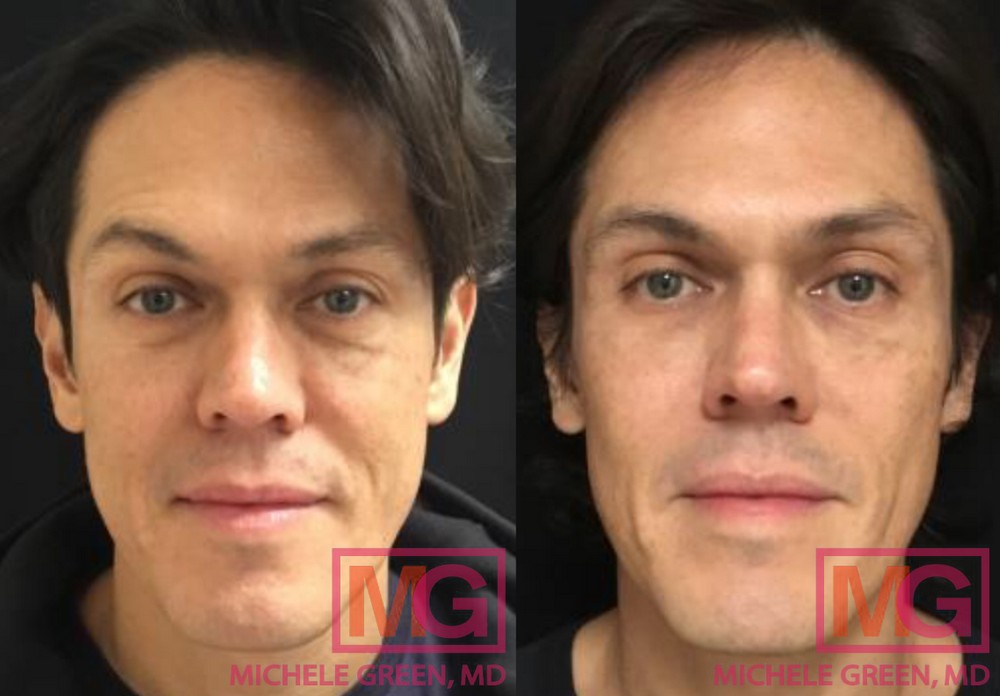
How to improve under-eye hollows with tear trough dermal fillers
Dermal fillers are among the most effective non-surgical treatment options for reducing the appearance of under-eye hollows. Tear trough fillers are hyaluronic acid-based dermal fillers designed to treat the sensitive under-eye area and rejuvenate the eyes. Hyaluronic acid is a naturally occurring substance that helps keep the skin firm, plump, and hydrated. When injected into the tear trough area, hyaluronic acid fillers can restore lost volume, diminish hollows and shadows, and refresh the look of the eyes. Using dermal fillers for the under-eye area can provide natural-looking volume, minimize hollows and dark circles, and offer minimal downtime with long-lasting results. Common tear trough fillers include Restylane, Belotero, and Juvederm. During your consultation, Dr. Green will evaluate you in person to determine which dermal filler is the best fit for your needs.
Restylane Dermal Filler
The two Restylane fillers suitable for use under the eyes are Restylane-L and Restylane Eyelight. Restylane-L is the original Restylane product used to address facial volume loss. Its flexible formulation allows for subtle, natural-looking rejuvenation in the tear trough area. Restylane-L can last from six to twelve months. Restylane Eyelight is one of the newest dermal fillers in the Restylane line, designed specifically to improve hollowness and under-eye bags. Its cross-linked hyaluronic acid molecules and patented NASHA technology help ensure the filler stays in place after injection. Restylane Eyelight can last up to 18 months.
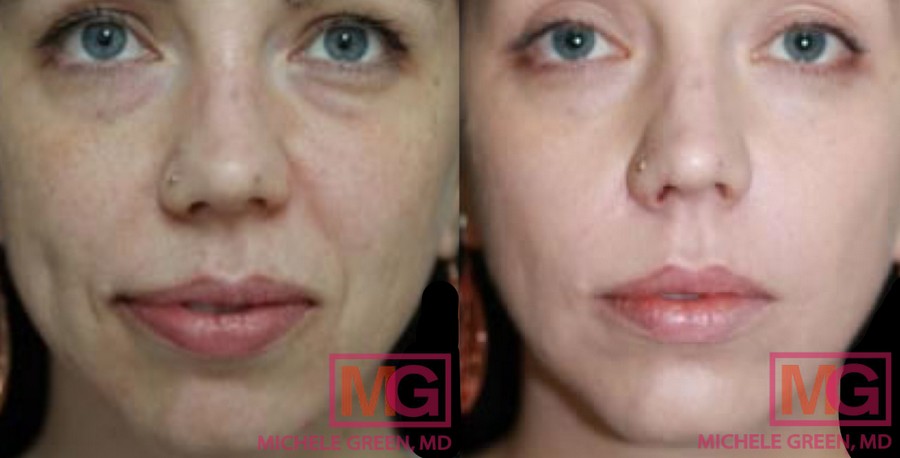
Belotero Balance Dermal Filler
Belotero is an ultra-thin hyaluronic acid filler often used to treat tear trough hollowing. Its flexible formulation and small particle size effectively prevent the Tyndall effect, which causes a bluish hue in the treated area due to light reflecting off suspended particles in the filler. Belotero generally lasts about six months in the tear trough region.
Juvederm Hyaluronic Acid Dermal Filler
Juvederm Volbella was the first FDA-approved dermal filler for treating the tear trough area. This dermal filler is the thinnest in the Juvederm family and uses patented VyCross technology to deliver smooth, even, and natural-looking results beneath the skin. Juvederm Volbella is specifically designed for this delicate under-eye area because of its slim, flexible consistency. The effects of Juvederm Volbella can last up to 12 months.
Who is a good candidate to improve hollow under-eyes with tear trough fillers?
Tear trough fillers are a suitable non-surgical option for healthy individuals with mild to moderate volume loss under the eyes, aiming to reduce the appearance of sunken eyes and hollowing. Patients should not have a history of severe allergic reactions, allergies to gram-positive bacterial proteins in hyaluronic acid, or allergy to lidocaine in hyaluronic acid fillers. Those with significant excess skin or fat deposits beneath the eyes may not be ideal candidates for tear trough fillers. During your consultation with Dr. Green, she will review your medical history and examine your under-eye area to decide if tear trough fillers are suitable for you. If you’re not a good candidate, Dr. Green will refer you to a trusted, board-certified dermatologist for a cosmetic surgery consultation.
What are the side effects of dermal fillers under the eyes?
Dermal fillers under the eyes are generally very safe and usually cause few side effects. Patients might notice mild redness, swelling, bruising, or pain at the injection site. These symptoms typically resolve on their own within two weeks. Nodule formation can also occur in the under-eye area, which usually clears up soon after treatment. If lumps or nodules do not disappear naturally, patients should visit their injector for assessment; they can use hyaluronidase to dissolve the dermal filler in that area.
Another rare side effect is the Tyndall Effect, which causes skin discoloration after hyaluronic acid filler injections. The injection site may appear blue if the hyaluronic acid is injected too shallowly. This color change is temporary, lasting a few months, but it can be quickly reversed with hyaluronidase injections, which dissolve dermal fillers. Although rare, more serious side effects such as blindness, stroke, and skin necrosis can occur if the filler is improperly administered or injected into a blood vessel. It is essential to have dermal fillers performed by an experienced injector, like board-certified dermatologist Dr. Michele Green in NYC. With over 25 years of experience with dermal fillers, Dr. Green uses her expertise to ensure your tear trough fillers are administered safely and effectively.
What is the best filler for under-eye hollows?
There is no single filler that works best for treating under-eye hollows. Dr. Green uses hyaluronic acid-based fillers like Restylane, Restylane Eyelight, Belotero, and Juvederm Volbella to restore lost volume and hydration in the tear troughs, helping to correct tired-looking and sunken eyes. These fillers differ in their formulations and the type of cross-linking used to support the injectable solution. Restylane-L and Restylane Eyelight utilize NASHA cross-linking technology to maintain the gel’s position. Belotero features an extremely thin and flexible formulation to reduce the development of the Tyndall Effect. Juvederm Volbella uses VyCross technology to create a smooth and even distribution under the skin. When you consult with Dr. Green, she will select the best filler for your eye rejuvenation based on your unique facial anatomy, skin concerns, and cosmetic goals.
How to get rid of sunken eyes and fix under-eye hollows naturally
While skincare alone might not fully eliminate sunken eyes or under-eye hollows, targeted eye creams and serums can help reduce their appearance. Since the under-eye area is very delicate, it’s important to choose the right product, which is why consulting with a board-certified dermatologist like Dr. Green is recommended. Dr. Green’s proprietary skincare line, MGSKINLABS, offers numerous products to address various skin concerns, including fine lines, wrinkles, skin laxity, pigmentation, and hydration. Dr. Green can recommend different eye creams or gels to enhance treatment results and revitalize the under-eye area.
During the day, an eye gel can provide temporary plumping and tightening to the under-eye area. MGSKINLABs Intensive Eye Repair is rich in antioxidants and hydrating ingredients to nourish the delicate skin under the eyes.
Retinol is an excellent ingredient for skin rejuvenation at night, as it helps slough off dead skin cells and reveal healthy, bright cells on the skin’s surface. By accelerating skin cell turnover and stimulating collagen production, this vitamin A derivative can help reduce fine lines and wrinkles, enhance skin elasticity, and increase moisture content for a more youthful appearance. The Eye Cream for Line and Wrinkle Repair from MGSKINLABs contains vitamin A, vitamin E, and squalane to rejuvenate and hydrate the skin under the eyes.
Other effective ingredients for eye rejuvenation include vitamin C and hyaluronic acid. Vitamin C is a powerful antioxidant that protects the skin from free radical damage and oxidative stress, increases skin cell turnover, and brightens skin tone. Hyaluronic acid is excellent for hydrating the skin and promoting suppleness and plumpness.
What other non-invasive treatments can rejuvenate the eye area?
Under-eye hollowing is not the only aging sign that appears around the eye; many patients also experience fine lines, wrinkles, mild skin laxity, and pigmentation. Fortunately, numerous treatment options are available to reduce these signs of aging and achieve a more youthful appearance. Dr. Green may recommend Botox injections, laser resurfacing, microneedling, chemical peels, or a combination of treatments depending on your specific skin concerns. During your consultation at her private Upper East Side dermatology office, she will assess your eye area and skin concerns to develop a personalized treatment plan that helps your eyes look refreshed and revitalized.
Botox injections to treat crow’s feet
Botox is one of the most popular cosmetic treatments worldwide because it effectively smooths dynamic wrinkles and fine lines on the face. Crow’s feet are dynamic wrinkles that develop at the corners of the eyes due to repeated facial muscle contractions during activities such as smiling, squinting, or laughing. Botox is a neuromodulator that primarily relaxes the muscles at the injection site by blocking neurotransmitters from signaling the muscles to contract. When injected into the corners of the eyes, the muscles relax, reducing crow’s feet and creating a more youthful look around the eyes. Botox usually takes about two weeks to reach its full effect, and results last for three to four months. Patients can maintain their results by scheduling regular treatment sessions.
eMatrix laser to reduce fine lines and wrinkles
The eMatrix laser is a resurfacing device designed to target fine lines, wrinkles, and uneven skin texture. It uses bipolar radiofrequency energy to stimulate the skin’s dermal layer, promoting the body’s natural healing process and boosting collagen and elastin production. The laser features a specialized tip made specifically to treat the delicate under-eye area, helping to reduce fine lines and creasing for a more refreshed appearance. Minimal downtime is needed, with patients possibly experiencing mild redness and swelling around the eyes for up to 48 hours. Multiple sessions are required to achieve the best cosmetic results.
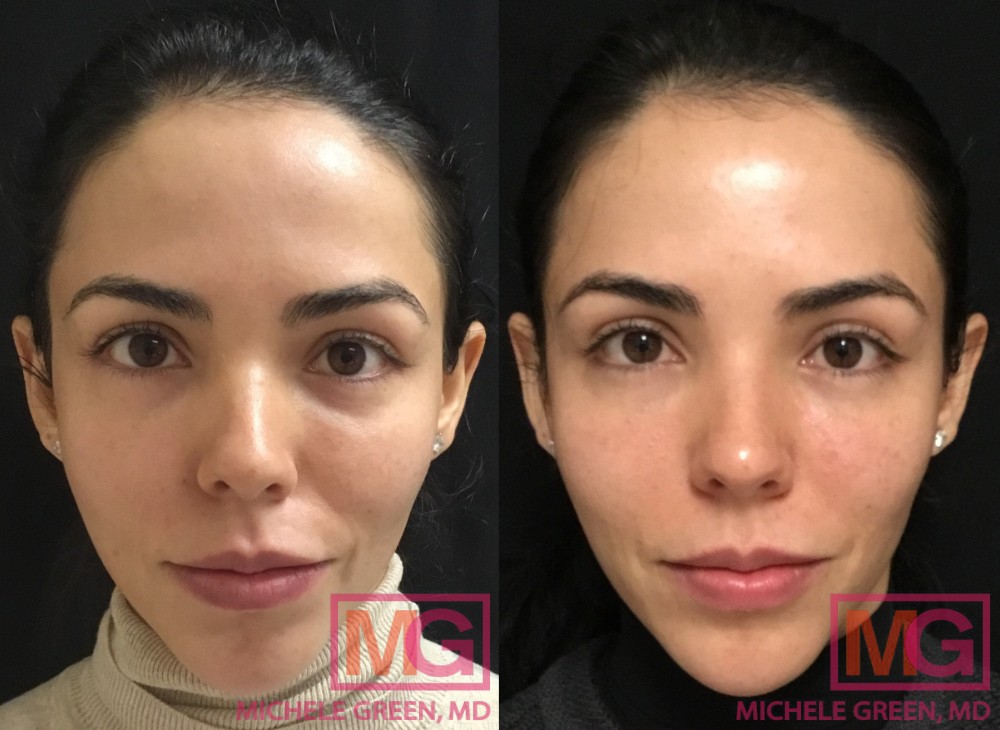
Thermage for skin tightening
Thermage is the gold standard treatment for addressing facial and body skin laxity. As the production of structural proteins, such as collagen and elastin, decreases over time, the skin around the eyes can become loose and droopy. Increased skin laxity can lead to a condition called “hooding,” where excess skin on the upper eyelid creates a hood-like appearance over the eye. Hooding can contribute to a tired look, and lax skin around the eyes is a clear sign of aging. Fortunately, Thermage can reverse these signs of aging by tightening the skin on the upper and lower eyelids, providing a non-surgical brow lift. Thermage utilizes radiofrequency energy to heat the deeper layers of the skin, stimulating the production of new collagen and remodeling existing collagen fibers for firmer, tighter, and smoother skin. Results typically take four to six months to appear, and their effects can last up to two years. Many patients choose to undergo annual Thermage treatments to maintain their skin-tightening results.
Microneedling for under-eye rejuvenation
Microneedling, also called collagen induction therapy, is a non-invasive cosmetic treatment used to address fine lines, wrinkles, uneven skin texture and tone, hyperpigmentation, acne scars, and enlarged pores. When applied under the eyes, microneedling can improve skin texture and tone, creating a more refreshed appearance. During the procedure, tiny, surgical-grade needles are moved across the skin, making microinjuries that activate the body’s natural healing process and boost collagen production in the treated area. When treating the sensitive eye region, Dr. Green typically uses needles that do not penetrate as deeply. Patients usually need at least three treatments, spaced one month apart, for optimal results.
One advantage of microneedling is that the microchannels formed in the skin increase the absorption of topical serums and products. Dr. Green often recommends combining microneedling with platelet-rich plasma (PRP) for enhanced rejuvenation. PRP is derived from the patient’s own blood and contains growth factors and proteins vital for tissue healing and regeneration. Including PRP in the microneedling process allows for quicker and more effective skin renewal.
Mesopeel periocular for minimizing hyperpigmentation
Mesopeel Periocular is a specially formulated chemical peel designed to address hyperpigmentation and discoloration in the sensitive eye area. Chemical peels use chemical solutions to exfoliate the skin, removing dead, pigmented skin cells to reveal healthy, brighter cells at the surface. Mesopeel Periocular contains a mix of skin-lightening agents, including azelaic acid, salicylic acid, and lactic acid, to help reduce dark circles and improve skin tone and texture. Multiple treatment sessions are necessary to achieve optimal cosmetic results.
FAQs about under-eye hollows
What causes hollow eyes or sunken under-eyes?
Sunken eyes, hollow under-eyes, or tear troughs are characterized by volume loss between the upper cheek and lower eyelid. This loss creates creasing and shadowing beneath the eyes, making them look darker, tired, and older. As we age, the production of collagen and elastin—the proteins that give skin structure—begins to decline, leading to volume loss and a hollow appearance in the face and under the eyes. Genetics can also play a role in the development of hollows, as some individuals are more prone to volume loss under the eyes than others.
How to get rid of hollow eyes
Tear trough fillers are an effective way to eliminate the appearance of hollow eyes. These hyaluronic acid-based fillers are used to restore lost volume in the area under the eyes. When injected into the hollows beneath the eyes, dermal fillers can reduce hollowness and improve shadowing in that region. Hyaluronic acid fillers, such as Juvederm, Restylane, and Belotero, provide immediate volume restoration upon injection and are highly durable. Many patients prefer dermal fillers over more invasive surgical options because they can eliminate hollow eyes without long recovery times, significant side effects, or incisions. When you consult with Dr. Green at her private NYC dermatology practice, she will evaluate your hollows and skin concerns to select the dermal filler that will give you a smooth, revitalized eye appearance.
How to get rid of sunken eye bags surgically
A blepharoplasty is a reconstructive eyelid surgery that removes excess skin to reduce the appearance of under-eye bags, puffiness, and sagging. Patients can have a blepharoplasty performed on just the upper or lower eyelid or on both. Those with hollowing under the eyes can also undergo a simultaneous fat transfer. During this procedure, fat grafts are taken from unwanted fat in another part of the body and injected into the under-eye area.
Downtime for a blepharoplasty usually lasts two weeks, and common side effects include swelling, bruising, and tenderness around the eyes. A blepharoplasty can be an excellent treatment choice for patients with significant excess skin or eye bags who are not good candidates for non-invasive procedures. However, fat grafting and fat transfers are generally not recommended in the under-eye area, as these procedures can lead to lumps and unwanted cosmetic outcomes in the delicate eye region. Instead, Dr. Green suggests that patients use dermal fillers such as Belotero or Restylane to restore lost volume in the tear trough area and achieve a natural, youthful look.
Does microneedling help under-eye hollows?
Microneedling cannot treat under-eye hollows because the procedure does not restore lost volume. However, microneedling can rejuvenate the under-eye area by minimizing the appearance of fine lines, creases, and discoloration. The treatment uses an applicator with tiny, surgical-grade needles that puncture the skin. When the needles pierce the skin, they trigger the body’s natural healing process, which increases collagen production in the area to revitalize the skin. Patients can combine microneedling with tear trough fillers to reduce under-eye hollows and address other signs of aging in the under-eye area, achieving a more youthful and refreshed appearance.
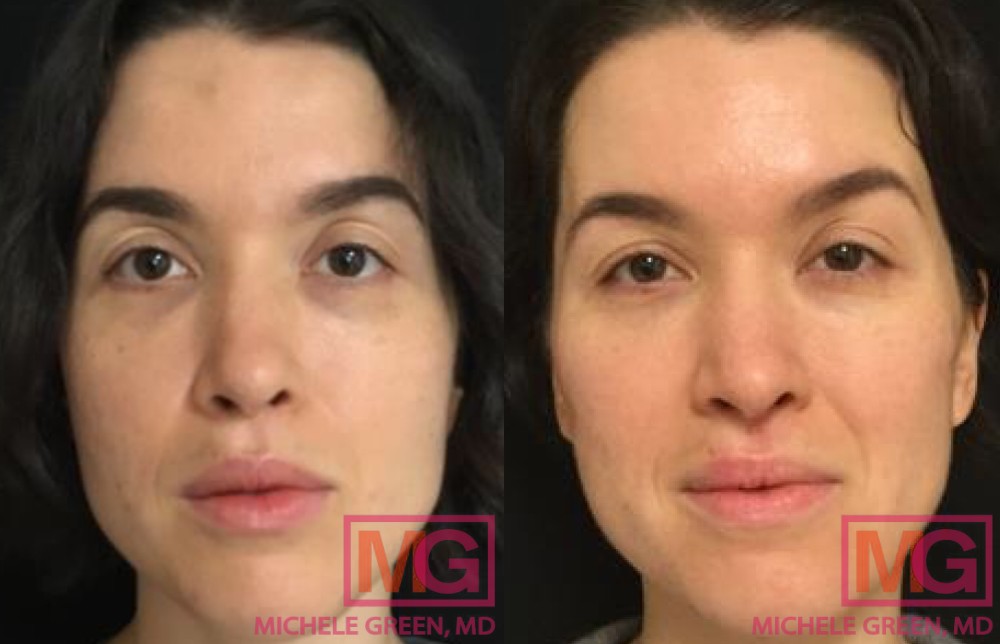
Can Botox help under-eye hollows?
No, Botox cannot help under-eye hollows. Under-eye hollowing refers to the volume loss between the lower eyelid and the upper cheek, creating the appearance of hollows under the eyes. The best treatment option for under-eye hollows is hyaluronic acid-based tear trough fillers, which provide immediate volume restoration to the under-eye area. Botox is a neuromodulator that inhibits facial muscles from contracting and forming fine lines, but it cannot address under-eye hollows. However, many individuals who undergo dermal filler treatment for under-eye hollows also use Botox to treat fine lines around the eyes for full eye rejuvenation.
How to fix under-eye hollows without filler
Fillers are the best option to fix under-eye hollows because they provide immediate volume restoration to the area. Patients who prefer not to use fillers can try eye gels and creams, which offer temporary plumpness. Non-invasive treatments like microneedling, eMatrix laser, and Thermage stimulate collagen production to reduce signs of aging, such as fine lines and skin laxity. While these treatments can rejuvenate the under-eye area and lessen fine lines and skin laxity, they do not add volume and cannot correct under-eye hollows. If you’re interested in improving the appearance of under-eye hollows, it’s best to consult a board-certified dermatologist like Dr. Michele Green in NYC. During your visit, she will evaluate your eye area to identify the most suitable treatment or combination of treatments to help you rejuvenate and revitalize your eyes.
How to conceal under-eye hollows
Many patients often wonder how they can fix under-eye hollows with makeup. While makeup cannot eliminate under-eye hollows, it can help significantly reduce their appearance throughout the day. One of the most important steps in using concealer is to prime the skin. It is best to use a primer or moisturizer that will plump and smooth the skin, allowing for a smoother makeup application. Patients experiencing shadowing or darkness under the eyes can use a peach or pink color corrector to diminish circles. Concealer can be gently applied under the eyes using a small concealer brush or your ring finger, pressing into the skin and being careful not to pull on it. Lastly, a translucent powder can be used to keep the makeup in place and set the product.
How to reduce sunken under-eyes and hollow eyes today
Sunken under-eye areas and hollows can be signs of aging, making you look tired and older. Fortunately, hyaluronic acid dermal fillers can restore lost volume under the eyes and smooth fine lines and wrinkles for a more youthful appearance. The procedure is quick and painless, with no downtime, allowing patients to return to their usual activities immediately. Hyaluronic acid fillers offer long-lasting results and consistently stunning outcomes. Patients can also choose treatments like Botox, Thermage, microneedling, eMatrix laser, and chemical peels to reduce fine lines, wrinkles, skin laxity, and discoloration for a complete under-eye rejuvenation. If you want to improve tired-looking under-eyes without surgery, long recovery, or side effects, Dr. Green in NYC is ready to help.
Board-certified cosmetic dermatologist Dr. Michele Green in New York City is a leader in the field with over 25 years of experience providing patients from around the globe with their ideal revitalizing results. Dr. Green offers a wide range of non-invasive cosmetic treatment options designed to address the various potential aging concerns that patients might have, including dermal fillers, Botox, and laser resurfacing. When you consult with Dr. Green, you will have the opportunity to discuss in-depth with her the specific signs of aging that you would like to target, as well as your overall aesthetic goals. Dr. Green will work with you to customize your treatment protocol, ensuring it is personalized to meet your needs and leaves you looking and feeling like the best version of yourself. To learn more about how to improve sunken eyes and reduce hollow eyes with dermal fillers, please call 212-535-3088 or contact us online to book an appointment today.
 212-535-3088
212-535-3088